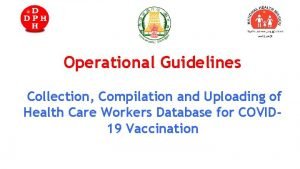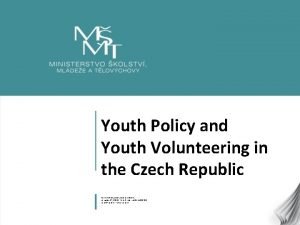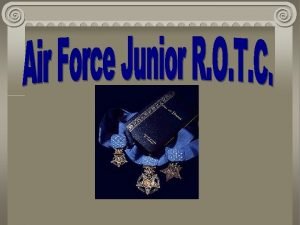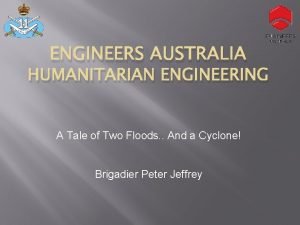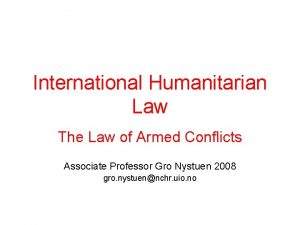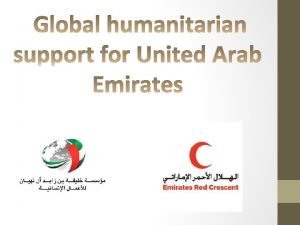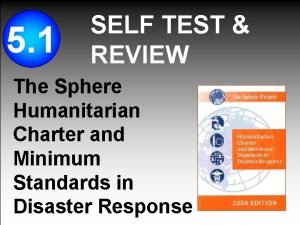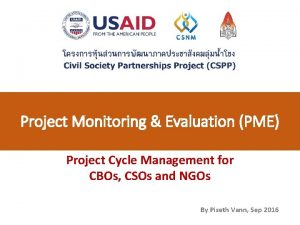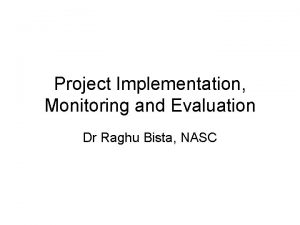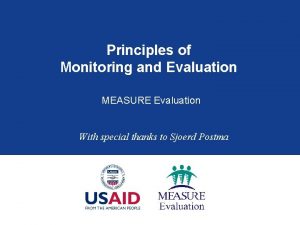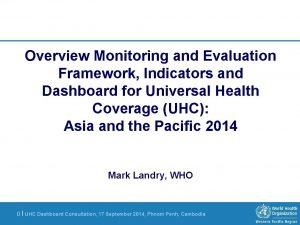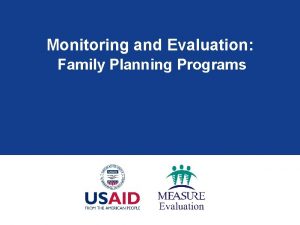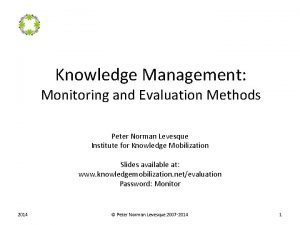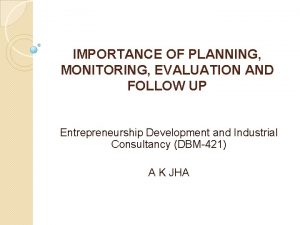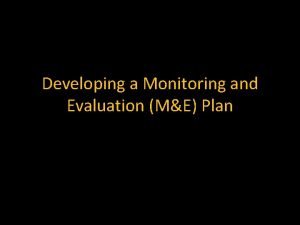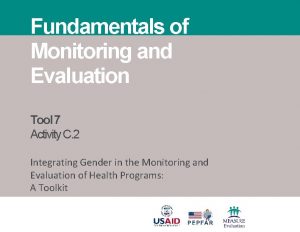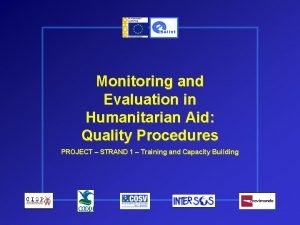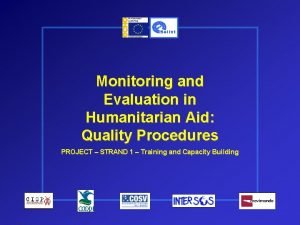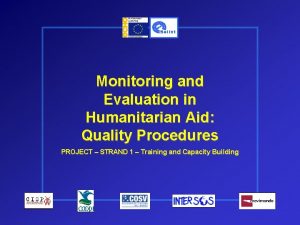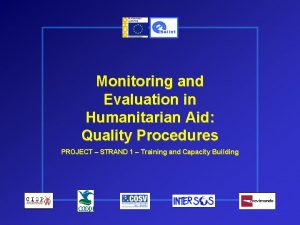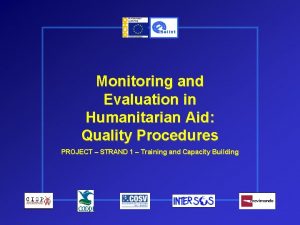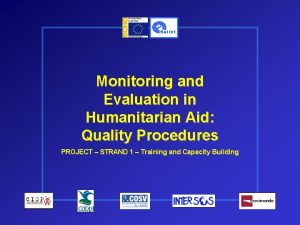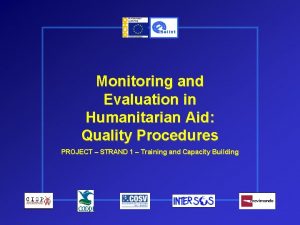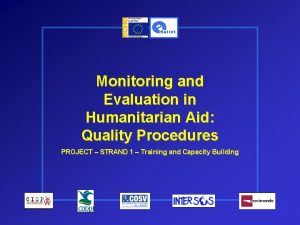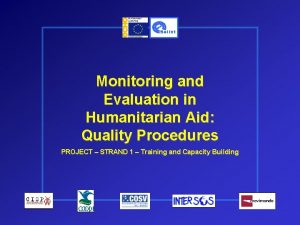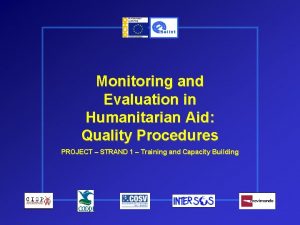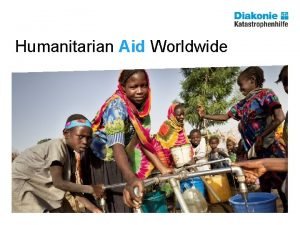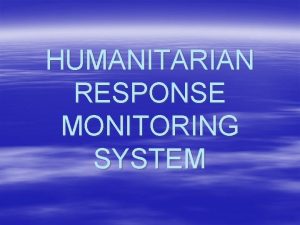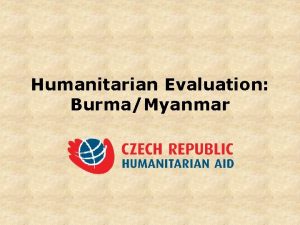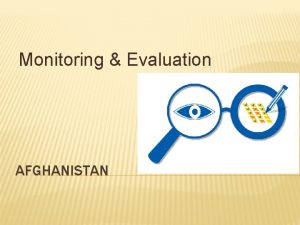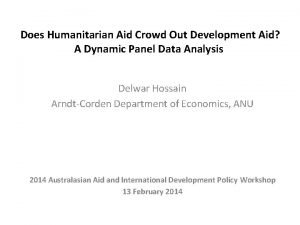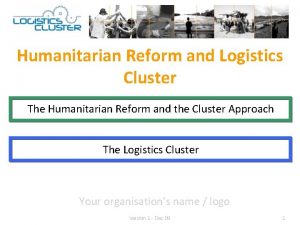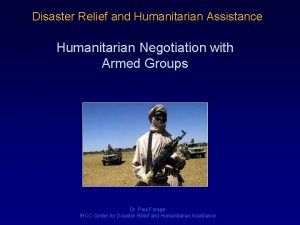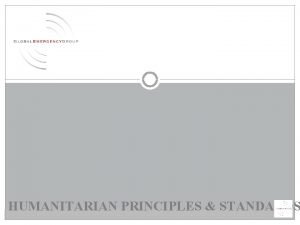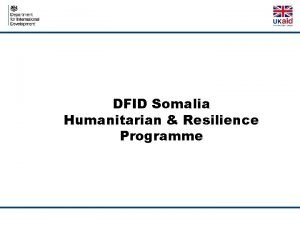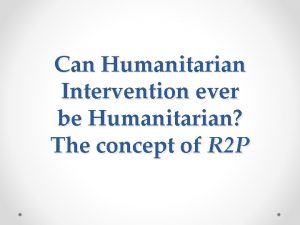Monitoring and Evaluation in Humanitarian Aid Quality Procedures
























- Slides: 24

Monitoring and Evaluation in Humanitarian Aid: Quality Procedures PROJECT – STRAND 1 – Training and Capacity Building

ANNEX I Single Form in collaboration with

the Single Form üA single form to ALWAYS use for: üProject proposals (any type) üInterim Narrative Report üPre final Narrative Report üFinal Narrative Report

the Single Form üPreparation of the Single Form requires knowledge of the ECHO PCM manual üThe following must be enclosed: ü Logframe ü Workflow ü Map of the area üOther documents should be enclosed as required by the situation

the Single Form ‘ Complexity of the project Focus on Evaluability of the project

Ele me nt o s f int ere st SF: proposal üThe SF is composed of 13 sections üAll sections are completely filled in to “convince” of the importance of proposed operation üLess detail is required for operations of primary emergency and emergency

SF: proposal The following points shall always be respected Maximum lenght 25 pages Estimate of needs and definition of strategy PCM log (objectives, indicators, sources) Specific information (no repetition)

Ele me nt o s int f ere st SF: “Sections” 2. Need Assessment ü A precise stakeholders analysis is required ü Problem tree should be used as an instrument to analyze and synthesize problems ü If an assessment exists it shall be enclosed (at least a summary)

Ele me nt o s int f ere st SF: “Sections” 3. HO Strategy ü The presence of the HO in the country/area is explained specifying: ü Location, sectors, donors ü Lessons learnt ü Chosen strategy is discussed ü Proposals shall always be discussed with regional ECHO representatives

Ele me nt o s f int ere st SF: “Sections” 4. Operational Framework In general ü Logical Framework mandatory (max 3 pages) ü Title of operation must not exceed 240 characters ü Requirements inserted in SF must be scrupulously respected

Ele me nt o s int f ere st SF: “Sections” 4. Operational Framework In Particular ü Precise details are required for the beneficiaries (number, type, category, location…) ü Identification criteria are clearly defined ü Activities are sub-divided into sectors (budget, categories)

Ele me nt o s int f ere st SF: “Sections” Continuing with sez. 4: the objectives ü General objective (called principle objective here) shall be in line with the objectives specified by the EC decision ü Insert only 1 specific objective ü Centrality of indicators (details for all expected results) and monitoring mechanism

Ele me nt o s f int ere st SF: “Sections” 5. Risks & Assumptions ü External factors are explained and monitored ü The field safety situation is outlined and, if they exist, specific protocols for the operative context in question

Ele me nt o s f int ere st SF: “Sections” 6. Resources Required üLocal and expatriate staff are divided (1 & 2) üFunction is specified and estimated costs discussed üPurchasing procedures are detailed (goods, equipment)

Ele me nt o s f int ere st SF: “Sections” 7, 8, 9. LRRD , Mainstreaming & Visibility/communication strategy ü The questions “substainability” and “mainstreaming” are discussed ü If there are funds for visibility the expense must be justified (Visibility Plan)

Ele me nt o s int f ere st SF: “Sections” 10. Field Coordination and local implementing Partners ü Mechanisms of connection are explained (Field coordination) ü Procedures foreseen for contracts for supplies, services and works are defined (explaining if action different from the EC procedure is taken and the procedure to be followed)

Ele me nt o s int f ere st SF: “Sections” 11, 12, 13. Financial & administrative information & conclusion üBasic information on the project is stated üSpace for conclusions and comments

Ele me nt o s int f ere st SF: Interim Report üThe same format of the proposal is used (Single Form) üIt must state in detail progress made STRICTLY following the original plan ü Logframe representing the progress made is reported

Ele me nt o s f int ere st SF: Interim Report ü To change parts insert activities and changes made, insert the phrase Not Applicable in parts not modified ü Section 4 becomes the most important section with special attention to: The beneficiaries The indicators

Ele me nts o inte f res t SF: Interim Report Special attention must be paid to: ü Note the starting date of the operation and in case of inserting a date different from that specified in GA, give a reason ü Request, with a justification, any eventual extension of the implementation period ü Do not modify in any way the specified objective ü Duly justify any inherent changes in budget

Ele me nt o s int f ere st SF: Pre-final Report üMandatory only for the types of decision which call for it üAlways the same format üSubstantially similar in form and objective to the Interim Report

Ele me nt o s f int ere st SF: Final Report üUse the same format (Single Form) üDefines the framework reached at end of operation üThe “rules” of filling it in remain unvaried

Ele of me int nts ere st SF: Final Report ü Previously used methods for supplying information are still valid ü Extreme care must be made in filling the Sections 4 (Operational Framework), 6 (Resources), 7 (LRRD), 8 (Mainstreaming) e 9 (Visibility) ü All additional comments are to be made in section 13 ü Indicators (levels reached), modifications made to plan and possible impact are detailed and discussed ü All details of procedures followed for the contract are supplied

The end
 Pregnancy and infant cohort monitoring and evaluation
Pregnancy and infant cohort monitoring and evaluation Ee.humanitarian response.info/x/vpdlixjf
Ee.humanitarian response.info/x/vpdlixjf Humanitarian work psychology
Humanitarian work psychology Humanitarian projects in prague for youth
Humanitarian projects in prague for youth Humanitarian
Humanitarian Humanitarian programme cycle 2021
Humanitarian programme cycle 2021 Longevity ribbon jrotc
Longevity ribbon jrotc Afjrotc distinguished cadet badge
Afjrotc distinguished cadet badge Humanitarian engineers in cape york
Humanitarian engineers in cape york International humanitarian law icrc
International humanitarian law icrc International humanitarian law icrc
International humanitarian law icrc International humanitarian law notes
International humanitarian law notes Khalifa humanitarian foundation
Khalifa humanitarian foundation Domistan
Domistan Humanitarian work psychology
Humanitarian work psychology Project monitoring cycle
Project monitoring cycle Comparison between monitoring and evaluation
Comparison between monitoring and evaluation Principles of m&e
Principles of m&e Monitoring and evaluation dashboard
Monitoring and evaluation dashboard Monitoring and evaluation of family planning programs
Monitoring and evaluation of family planning programs Knowledge management monitoring and evaluation
Knowledge management monitoring and evaluation Importance of planning, monitoring and evaluation
Importance of planning, monitoring and evaluation Me plan
Me plan Principles of monitoring and evaluation
Principles of monitoring and evaluation Basics of monitoring and evaluation
Basics of monitoring and evaluation

